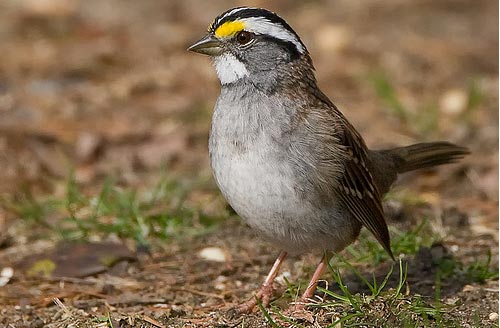Learn a Flight Call: White-throated Sparrow
By Lewis Grove, Cornell Lab researcher
May 13, 2009
Whether you already know their call or not, right now is a great time to get out and listen for White-throated Sparrows.
They’re one of the most common nocturnal migrants across much of the country right now. These striking winter visitors are just now departing from backyards for their boreal breeding grounds, and if you have sharp ears you’ll hear their distinct seep calls both during the day, as they forage below shrubs, and at night as they fly overhead.
Unlike thrushes and many warblers, sparrows often use their daily contact call while migrating at night. That makes them a great place to start when you first try to pick out calls from nocturnal acoustic traffic. We don’t know if there are simply a lot of White-throated Sparrows or if they’re a particularly vocal species (or both!), but there is usually no shortage of White-throated Sparrow flight calls during early spring or late fall. Let’s have a look and a listen.
The White-throated Sparrow’s call is readily identifiable from a spectrogram: typically 115-190 milliseconds in duration and 7.2-9.5 kiloHertz in frequency (see our previous post for a refresher on spectrograms). The general structure is a double- or sometimes triple-banded seep note, which can be broken into two parts: a slightly descending introduction followed by a wispily modulated ending (that’s the squiggly second half of the spectrogram). That modulated ending is particularly important, distinguishing it from similar calls of Song, White-crowned and Fox sparrows.
Identifying the spectrogram is pretty straightforward, but as with all flight calls, it’s more difficult to do it “live,” with just the sound. Here is an example of the call slowed down to quarter speed. Listening to this slower version allows you to hear the features that make up the call.
[viddler id=40484c24&w=247&h=205]Listen to this a few times and concentrate on the way the introductory note slides down in pitch into the wispy ending. Then try this version, now at half-speed.
[viddler id=1ad315e3&w=247&h=205]Can you still hear those specific characteristics? With a few more listens at each speed, soon you should be able to recognize those details even at full speed. Did you realize you could actually hear subtle characteristics of a call that lasts less than two-tenths of a second?
You’re now ready to listen for White-throated Sparrows flying over your house tonight, but until the evening comes it helps to use a few tools. Basic weather information can help you gauge the possibility of a good flight. In spring, look for winds out of the south, which provide a tailwind for northbound spring migrants as well as warming temperatures.
Also, pay attention to what you’re seeing at your favorite birding haunts, from local reports, or from eBird. Chances are good that if White-throated Sparrows are around during the day, they are also migrating over your area at night. A quick glimpse at the past five years of eBird data shows both wintering and breeding ranges. A look at just the past month of reports shows that the sparrows are indeed moving northward across much of the eastern half of the country and in lower densities throughout the west.
So take a few minutes tonight and start working on your nighttime bird list!

All About Birds
is a free resource
Available for everyone,
funded by donors like you
American Kestrel by Blair Dudeck / Macaulay Library
